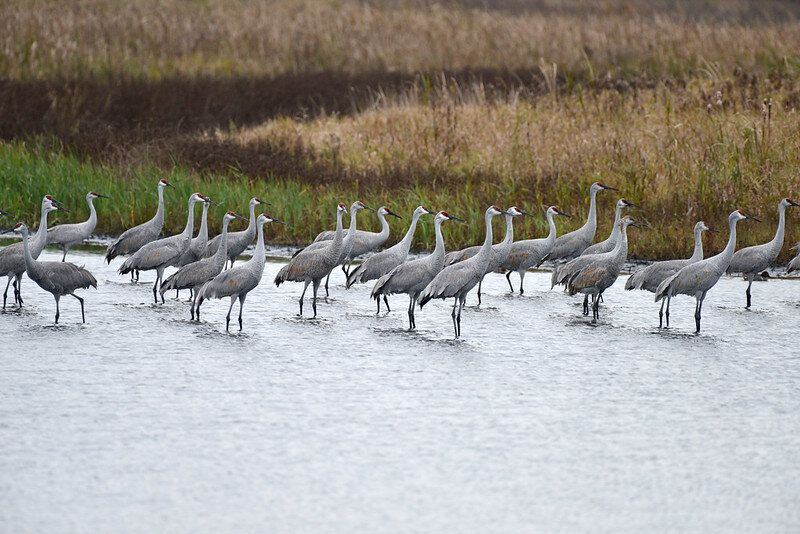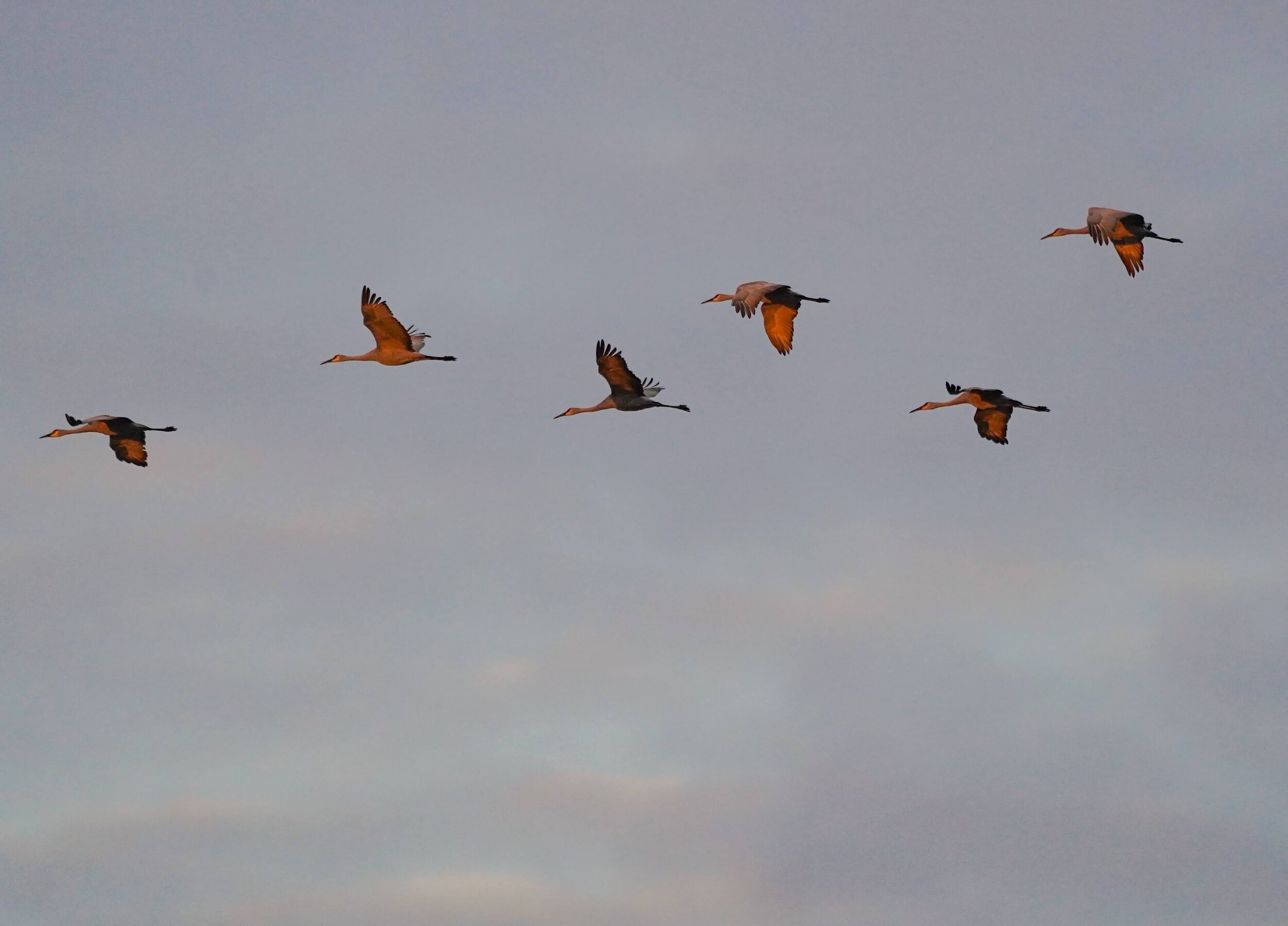Banner Photo: Sandhill Crane in flight by Deb Winarski
Welcome to our new monthly post, The Up and Up, which will provide fascinating information and resources to learn more about Chicago-area birds, for both beginner and experienced bird lovers. The Up and Up is written by Drew McPartlin, a new addition to our volunteer communications team.
The weather is getting chillier, the leaves are falling from the trees – but don’t despair, there’s still a whole lot happening with some truly remarkable local birds. While it’s certainly late in the bird migration season, the Chicago area still has a great treat for us – the magnificent Sandhill Crane, on its way to its wintering grounds in Florida and the southeastern US. We at CAS are here to help you understand a bit more about this wonderful bird and where you can go see some of them as they take a break nearby on their way down south!
Before we dive in, let’s take some time to get a basic understanding of the Sandhill Crane. As you might be imagine, the Sandhill Crane is a tall bird, typically 3-5 feet when standing at its full height, but quite sleek and light, weighing in at a range of 6.5-14 lbs. Adults will have a red patch on the forehead with black legs, and magnificent plumage in varying shades of grey and brown. Their bills are long, dark and pointed, and the length can vary by subspecies. They have large wingspans (5.5-7.5 ft.), and you’ll see them soaring along similar in style to hawks and eagles, only flapping their wings when it is needed. While they are flying, you’ll see their long dark legs trailing behind and their necks kept straight (the latter being a key difference to similar-looking birds!). You can identify juvenile cranes by their cinnamon-brown feathers .
Here are some images to bring this fantastic bird to life:



Now that we’ve given you a good grounding in this local gem, you may realize that you have seen a few around! Or, perhaps, you may have seen some of their similar cousins. There are a few common birds that you may have seen, such as egrets or herons. Let’s take a minute to understand some differences:
It turns out, egrets are actually just a type of heron! They belong to the same family of birds, and many lie within the same genus (does everyone remember their scientific taxonomy from Biology class?) Take the Ardea genus, for example – it contains the Great Blue Heron, which is fairly common throughout North America, and the Great Egret, common throughout tropical and temperate regions throughout the world. Both birds are tall, with long necks, bills, and legs – and from afar, could bear a passing resemblance to some crane species.
Here are some key differences between egrets/herons and cranes:
One quick way to tell the difference is to look at the neck of the bird – cranes’ necks are shorter than herons’ or egrets’, and they typically hold them straight. This becomes most obvious when the bird is in flight. According to the National Wildlife Federation, “Herons curve their necks into an ‘S’ shape and when they are flying they pull them totally back, while cranes’ necks stick straight out.”
Cranes typically have shorter beaks than herons/egrets as well.
It’s truly a treat to see the Sandhill Crane and its close cousins. The Sandhill Crane was close to extinction in the 1930s due to human infringement on their territory and hunting. Their comeback is definitely a conservation win. We have 5 migratory populations, grouped by the Migratory Flyway that they use across the United States and their differing breeding and wintering grounds.
The Sandhill crane plays a large role in the culture and identity of Miami people. Bradford Kasberg, citizen of the Miami tribe and wetland restoration manager for Audubon Great Lakes, explains. “This is likely because the Sandhill crane’s eastern migration route travels directly through what is now Northeast Illinois and across the Wabash River valley in Indiana, which are both important areas of our homelands. We have used the symbol of the Sandhill crane to represent our community, emblazoning images of the bird on trees to demark territories or drawing the bird to represent our community’s agreement on treaties. Now the bird appears on our tribal seal and is a frequent subject in our community’s artwork. Other tribes even refer to us as the ‘Twigh Twee’ or ‘Twatwa’ people, which is an onomatopoeic term for the distinctive call that the Sandhill crane makes, with some tribes claiming Miami people could turn into the crane.”
“The connection to the crane is more than about identity making, however. One of the earliest months in our lunar calendar, cecaahkwa kiilhswa, or the Sandhill crane moon, occurs when the birds return from their winter grounds. This signifies one of the earliest transitions into spring, making the bird’s migration a welcome sign of warmer weather to come.”
The population most relevant to us in Chicago is the Eastern Migratory population. On average, it is made up of about 81,000 birds which make their breeding grounds throughout the northern Midwest in Wisconsin, Illinois, Minnesota, and even in southern Canada. Some of these birds have recently returned to breed in the marshes of our area after a long absence. They will follow the Eastern Flyway to winter in the southeastern US (overlapping with some of the special non-migratory Sandhill Cranes, which have populations in Mississippi, Florida, and even Cuba!). (Source: The Trumpet in the Orchestra of Evolution: The Story of the Sandhill Crane in North America webinar, International Crane Foundation, April 2020). As you are enjoying the flocks flying over Chicagoland, look out for a white crane among them which would be a much rarer Whooping Crane.
We are lucky enough to be able to see some of these Eastern Sandhill Cranes in spectacular fashion. About 1.5 hours from Chicago is Jasper-Pulaski Fish and Wildlife Area near Knox, Indiana, where right now many Sandhill Cranes are taking a break on their way to their wintering grounds down south. Thousands upon thousands of cranes will be making a pit stop in the marshy wetlands. As recently as November 5, over 11,000 birds were counted in the area! They begin to gather there in September, with the numbers peaking in mid-November. (See if you can take a short drive this weekend!).
The best times to see them are sunrise and sunset, and the best views can be seen from Goose Pasture Viewing Area. Here are some photos of past migrations, below. We hope that you can make it out to see the magnificent birds!





